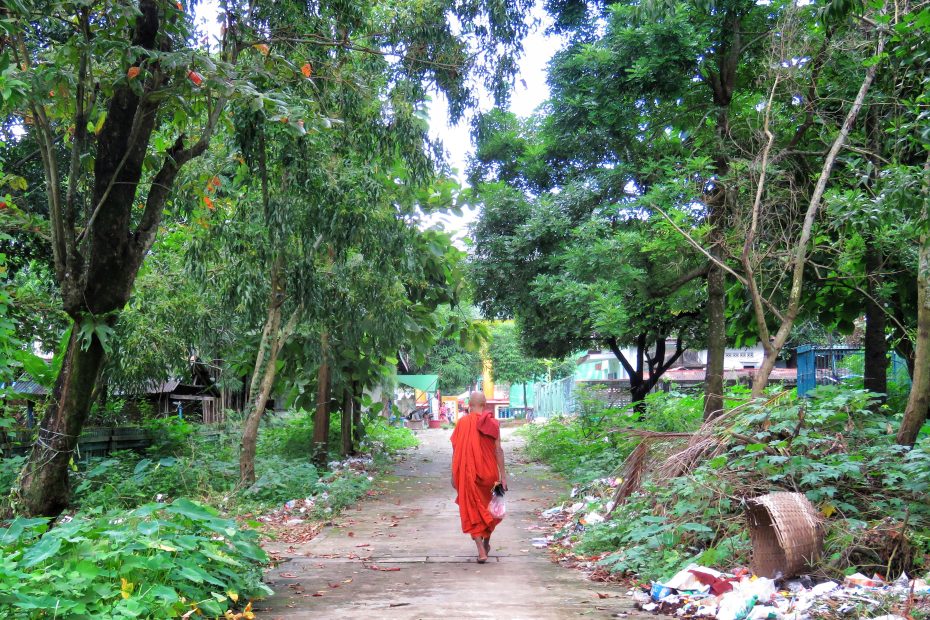Table of Contents
Introduction
The small village of Mingun in northern Myanmar is home to one of the most iconic and impressive structures in the world – the Mingun Pagoda. This massive unfinished pagoda towers above the Irrawaddy River, standing as a testament to the grand vision of King Bodawpaya in the late 18th century. Though never completed, the Mingun Pagoda has endured over the centuries and continues to draw visitors who marvel at its sheer size and unfinished beauty.
History of Mingun
Mingun was founded in 1790 by King Bodawpaya as a new capital for his Kingdom of Ava. He envisioned the city becoming a great religious center, with lavish temples and pagodas built along the river. Construction began on several massive projects, including what was intended to be the largest pagoda in the world.
Over 20,000 workers labored to build the extravagant structures Bodawpaya had designed. The Mingun Pagoda was to stand 480 feet tall, far surpassing any existing pagoda.construction Among other structures were a gigantic 90 ton bronze bell and the Settawya Pagoda. However, only a decade after it began, construction at Mingun halted following Bodawpaya’s death in 1819.
The Mingun Pagoda
Planning for the Mingun Pagoda likely began around 1790 when the city was founded. Bodawpaya envisioned a monument that would surpass the Shwedagon Pagoda in Yangon as the tallest pagoda in Myanmar. The massive square base was built from thousands of bricks, rising in three terraces along the riverbank.
Had it been completed, the Mingun Pagoda was intended to stand at a staggering 480 feet tall. For comparison, the Shwedagon Pagoda is 326 feet while the Great Pyramid of Giza is only 455 feet tall. The grandeur and imposing height of the unfinished pagoda is apparent as it dominates the Mingun skyline.
However, Bodawpaya died in 1819 with construction halted after reaching around 150 feet. Lack of funds and technical limitations prevented the full vision from being realized. Still, what was completed remains the largest unfinished pagoda in the world based on its intended height.
Current Status of the Pagoda
Over 200 years of exposure to the elements has damaged the Mingun Pagoda, with large cracks visible running vertically up the structure. The massive earthquake of 1838 worsened existing cracks and caused parts of the structure to collapse. However, substantial portions of the imposing brick base have survived.
Preservation efforts in the 1990s stabilized the structure, adding new brickwork to shore up damaged sections. A steel frame was also installed to support the weight and prevent further cracking. While no longer actively worked on, the Mingun Pagoda remains in a conserved state, allowing visitors continued access.
Visiting Mingun Today
The village of Mingun is located about an hour’s drive upriver from Mandalay, making it an easy and popular half-day trip. Most visitors arrive by boat, disembarking at the Mingun jetty and climbing the stone steps to the main pagoda site.
In addition to the unfinished pagoda, there are several other impressive structures to see. The Mingun Bell weighs 90 tons making it the largest uncracked bell in the world. Nearby is the beautiful all-white Settawya Pagoda and a giant cracked statue of Bodawpaya.
For tourists, Mingun provides a fascinating look at the grandiose vision of its founder. While never completed, the Mingun Pagoda has rightfully taken its place as one of Myanmar’s top landmarks.
The Future of the Pagoda
While there are no plans to resume construction, ongoing preservation efforts aim to maintain the structural integrity of the existing pagoda. With continued conservation, the remains can be preserved indefinitely as an open-air museum of sorts.
There have been controversial proposals to encase the entire pagoda in a giant steel tube, though this would drastically alter its unfinished aesthetic. Leaving the cracked brick terraces exposed to the elements may be risky, but also maintains the enigmatic charm.
Conclusion
The Mingun Pagoda stands as the incomplete testament to King Bodawpaya’s impressive vision for a religious capital at Mingun. Had it been finished based on the original designs, it would have been the tallest pagoda in the world by a large margin. While unfinished and damaged over time, the sheer grand scale of the Mingun Pagoda remains breathtaking to behold. Visiting Mingun and marveling at the brick terraces rising above the river allows one to imagine what could have been, as the world’s largest stupa stands unfinished awaiting an uncertain future.
FAQs
FAQ 1: When was construction on the Mingun Pagoda started?
Construction on the Mingun Pagoda likely began around 1790 when the village was founded by King Bodawpaya.
FAQ 2: How tall is the unfinished Mingun Pagoda today?
The unfinished pagoda today stands around 150 feet tall, about one third of the intended 480 foot height.
FAQ 3: What other structures can be visited in Mingun today?
In addition to the pagoda, visitors can see the 90-ton Mingun Bell, the all-white Settawya Pagoda, and a giant statue of King Bodawpaya.
FAQ 4: How can you travel to Mingun from Mandalay?
Most visitors take a boat up the Irrawaddy River from Mandalay, arriving at the Mingun jetty and then walking to the site.
FAQ 5: What efforts have been made to preserve the Mingun Pagoda?
In the 1990s, conservation work stabilized cracks and rebuilt damaged sections to prevent further deterioration.
